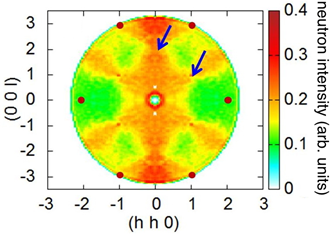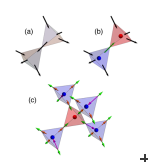Copyright 2012 neutronsources.org | All rights reserved. | Powered by FRM II | Imprint / Privacy Policy
Observation of magnetic fragmentation in spin ice
Date: 11/04/2016
Source: ill.eu
A Nature Physics publication on 4 April 2016: http://www.nature.com/nphys/journal/vaop/ncurrent/full/nphys3710.html
Spin ice is an unusual magnetic material in which the combination of strong local Ising anisotropy and ferromagnetic interactions imposes a local constraint to the magnetic moments, the “ice-rule” (see figure 1a). The magnetic state thus remains disordered but with specific local correlations. It belongs to the class of Coulomb phases, an original state of matter where the ground state is disordered, and the local constraint can be interpreted as the flux conservation law of electromagnetism.
Classical excitations in spin ice, called magnetic monopoles, are defects that locally violate the ice rule by reversing the orientation of a moment (see figure 1b), and thus induce a magnetic charge in the electromagnetic field. When the density of monopoles is large enough, an outstanding effect has been predicted by Brooks-Bartlett et al [1]: the emergent charged field can fractionalize into two parts, through the so-called “magnetic fragmentation” mechanism.
We have observed such “magnetic fragmentation” in a recently discovered material, the spin ice candidate Nd2Zr2O7, by means of neutron scattering measurements. This fragmentation (see figure 1c) manifests itself as a striking coexistence between an antiferromagnetic ordered state and a Coulomb phase with ferromagnetic like correlations. Experimentally, it manifests as the superposition of magnetic Bragg peaks, characteristic of the ordered phase, and a pinch point pattern, characteristic of the Coulomb phase (see figure 2). We further show that these two fragmented parts of the magnetic moment field behave independently.
Behind these observations, our experiments demonstrate that the electromagnetic field is “real” in these magnetic materials and highlight the relevance of quantum effects. They open a new route in the study of frustrated magnets.
The work could only be achieved through a series of neutron scattering techniques provided by ILL instruments: neutron diffraction on the D23-CEA-CRG diffractometer to observe the ordered fragment, polarized diffuse scattering and inelastic scattering on the D7 and IN5 spectrometers to observe the fluctuating part and the inelastic process.
This work is the result of a collaboration between LLB (CEA-CNRS), the Néel Institut (CNRS), the Physics Department of the Warwick University, INAC (CEA) and ILL.

Re.: Nature Physics, 4 April 2016. DOI: 10.1038/NPHYS3710
Contact: Dr Jacques Ollivier ; Dr Hannu Mutka ; Dr A. Wildes
[1] Brooks-Bartlett, M. E., Banks, S. T., Jaubert, L. D. C., Harman-Clarke, A. & Holdsworth, P. C. W. Magnetic-moment fragmentation and monopole crystallization. Phys. Rev. X 4, 011007 (2014).
S. Petit, E. Lhotel, B. Canals, M. Ciomaga Hatnean, J. Ollivier, H. Mutka, E. Ressouche, A. R. Wildes, M. R. Lees and G. Balakrishnan, Nature Physics, AOP (2016) DOI: 10.1038/NPHYS3710.
